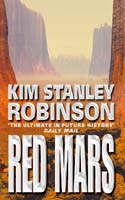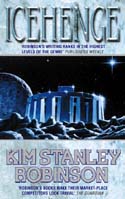

The colonization of Mars has been a quixotic dream of humanity for many decades; in this novel Kim Stanley Robinson postulates a very plausible scenario as to when, where, and how this fantasy could be, possibly should be, achieved. The novel opens some decades after the original international crew of one hundred astronauts, comprised of fifty women and fifty men, arrived on the red planet. Through the recounts of four of the main protagonists, in retrospect - main antagonists, we are given a marvellously portrayed experience of life within the first settlers and of how they industriously attempt to make Mars their new home. John Boone, Nadia Toitovna, Frank Chalmers, and Moya Chereshevsky are people to whom a tremendous amount of time is given. Frontier worlds and especially their settlers need to be tough, resourceful, loyal and able to work within a group environment; the author relates how through of the characters Mars is set to be changed forever. This book is definitely hard science, however, it primarily through a biological, geological and geographical sharpened sword with which the author uses to cleverly educate and inform how a desert (dead) planet needs to be understood, and the measures needed to terraform it into a planet capable of supporting aerobic life. Though at times a ponderously slow novel, the sense of wonder and near endless opportunities humanity could possess in exploiting a new world will come at a very high price. Amidst the euphoria of thriving settlements popping up on Mars, Earth and its political and multi corporations (transnationals) avariciously seek to inundate the planet with its burgeoning ten billion plus population and exploit its natural resources. Overall one could only describe Red Mars as a very intelligent future history. The reasons for doing so are legion. Bittersweet and poignant, the novel bears all the hallmarks of a wonderfully detailed and well researched masterpiece.


This short novel is a tale of mystery, archaeology, political upheavals and human ingenuity. In the twenty third century, thanks to medicine, human beings have the capacity to live for centuries. Set across four hundred years we are introduced to three characters: Emma Weil, Hjalamr Nederland, Edmond Doya. Emma Weil finds herself unwittingly caught up in a mutiny aboard the spaceship she travels while returning to Mars. She is drawn into the conflict against a government that is in the pockets of the Terran mother planet. She sympathizes with the mutineers and becomes active. Her story ends up as a mystery - buried by the Martian government - until the discovery of her journals. Hjalmar Nederland, a Martian archaeologist, discovers Emma's journals and becomes totally enamoured by her first hand history of the revolt: this discovery is met very suspiciously and coolly by a government that has suppressed so much. It is during this excavation that an amazing piece of news is relayed to the archaeologists: a structure has been discovered at the north pole of Pluto. This pushes Nederland's discovery into the scientific background. Nederland's episode in this novel is the strongest of the three interconnecting vignettes. Robinson's prose in recollecting Nederland's manic and desperate need to search for the truth is beautifully recounted thusly on page one hundred and fifty two: Hours passed, but that maze of canyons and the map. It is a form of grace to believe in nothing but a task: one can believe in meanings because they are all that exist. On page one hundred and sixty three, coming close to death, Nederland's processes begin to coherently focus on his own picadilloes : So I had lived my life on false promises. All those complaints about the pain of existence - what a fool I had been to ape the ennui of the immortal, ignoring the flesh metronome ticking inside, marking each of a finite number of moments we could never return to. I had behaved as if I were a god, and hiked alone into the chaos careless of my own life: and in the cold night learned better, the hard way. To live and yet no to have experienced the true measure of one's own life strikes like the proverbial bolt of lightning from a clear blue sky. The final recollection is that of Nederland's great grandson. Edmond Doya owes no allegiance to his antecedent's work. His belief is that Icehenge, and those who constructed it, left it there as a message to future generations. In fact the theories put forward as to why it was constructed like Stonehenge vacillated from the sublime to the ridiculous. He will land on Pluto and carry out a thorough examination on the monument. He receives as many questions as answers as he probes this anachronism. Different perspectives across three characters and millions of miles of space made Icehenge a gripping read.

| Authors | Awards | Blogs |
| Fanzines | Index | Magazines |
| Publishers | Retailers | Reviews |